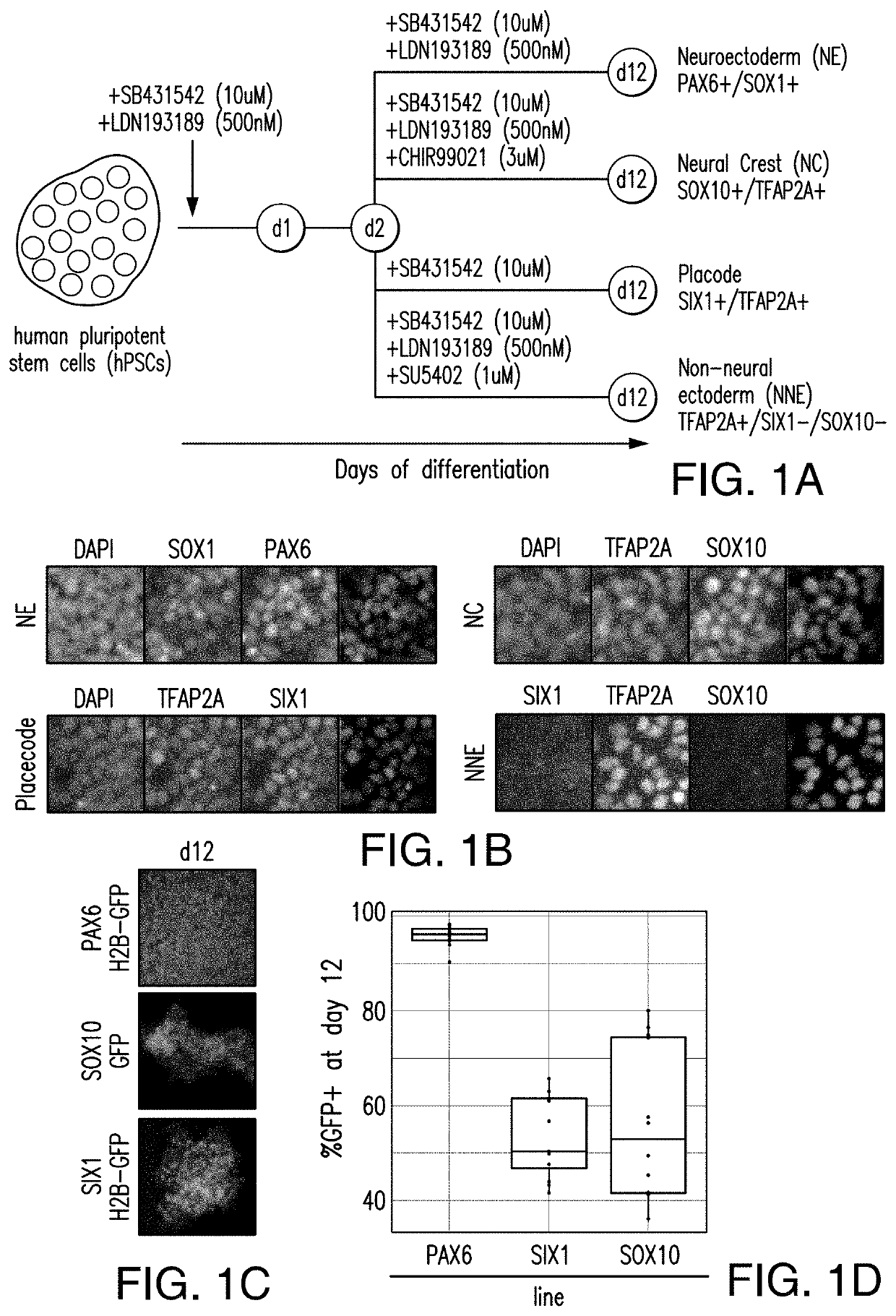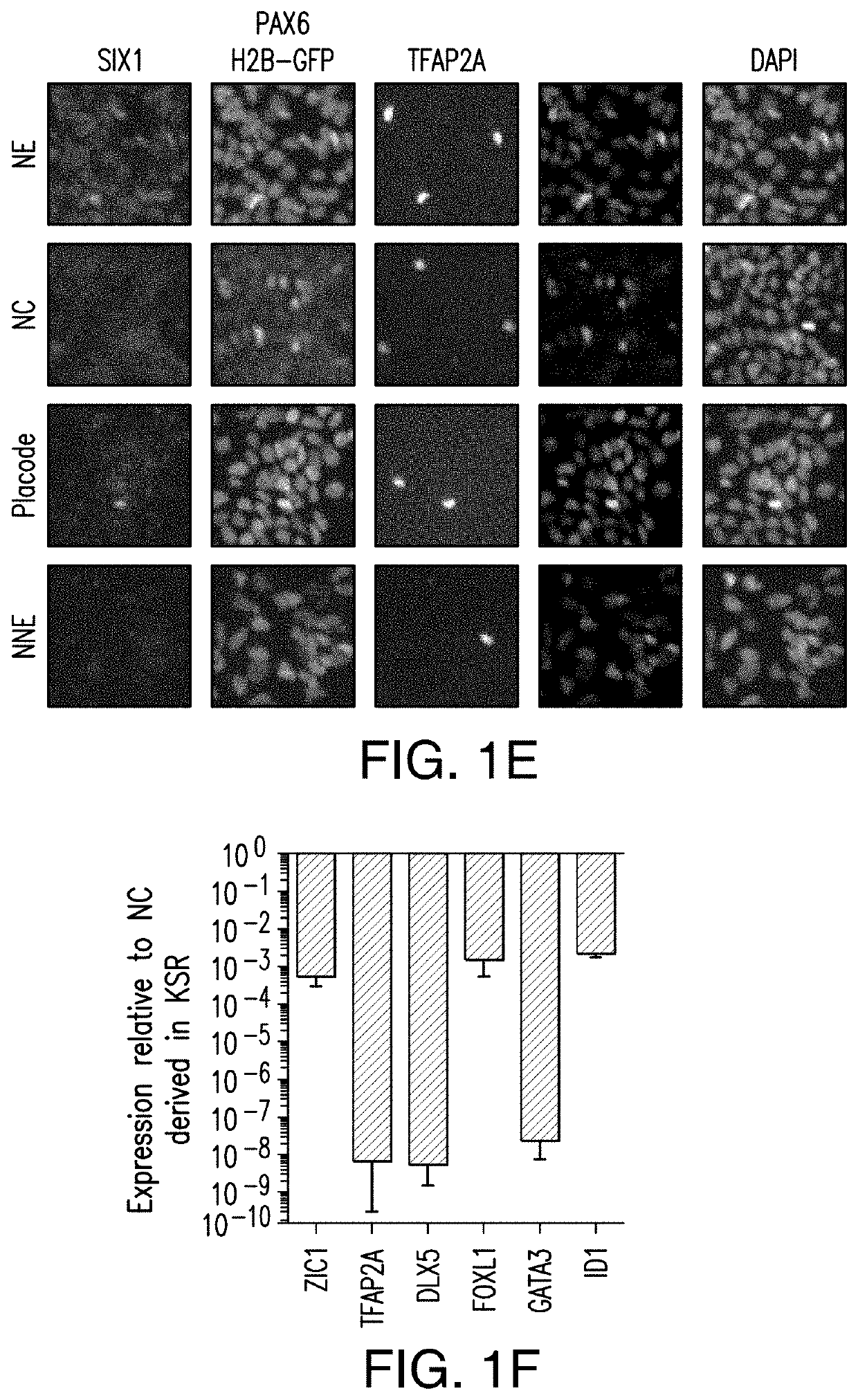Methods of differentiating stem cell-derived ectodermal lineage precursors
a technology of stem cell-derived ectodermal lineage, which is applied in the direction of genetically modified cells, drug compositions, skeletal/connective tissue cells, etc., can solve the problems of preventing the development of more ambitious strategies aimed at generating dozens or possibly hundreds of defined cell types in a modular fashion
- Summary
- Abstract
- Description
- Claims
- Application Information
AI Technical Summary
Benefits of technology
Problems solved by technology
Method used
Image
Examples
example 1
6.1 Example 1
Methods Of Preparing Stem Cell-Derived Progenitor Cells of the Neuroectoderm (NE), Neural Crest (NC) Cranial Placode (CP) And Non-Neuro Ectoderm (NNE) Ectodermal Lineages
Summary
[0215]Human pluripotent cells (hPSCs) can give rise to potentially any cell type of the body. A long-term goal is the development of strategies to re-create the complete human lineage tree in vitro. Such an effort depends on establishing modular differentiation platforms that provide access to each of the three germ-layers. Here we present a strategy to derive all four main ectodermal lineages (CNS, neural crest, cranial placode, non-neural ectoderm) in parallel under fully defined conditions. Using genetic reporter lines, we demonstrate a dose- and time-dependent role for BMP signaling in driving non-CNS ectodermal derivatives. We apply gene-editing tools to dissect mechanism of early cell fate decisions and further demonstrate the utility of our platform in a chemical screen for compounds that ...
example 2
6.2 Example 2
Derivation of Diverse Hormone-Releasing Pituitary Cells from Human Pluripotent Stem Cells
Summary
[0263]Human pluripotent stem cells (hPSCs) represent a potentially unlimited cell source for applications in regenerative medicine. Hormone producing cells may be particularly suitable for cell therapy applications, and the treatment of pituitary gland dysfunction may be a potential therapeutic target. Previous studies have demonstrated the derivation of pituitary lineages from mouse ESCs using 3D organoid cultures that mimic the developmental interactions involved in pituitary gland development in vivo.
[0264]The present example describes a simple and highly efficient strategy to derive anterior pituitary lineages from hPSCs using chemically defined monolayer culture conditions suitable for cell manufacturing. We demonstrate that purified placode lineage can be induced towards pituitary fate using defined cues in the absence of complex co-culture conditions. Using single cell...
example 3
6.3 EXAMPLE 3
Derivation of Neural Crest from Pluripotent Stem Cells
[0337]Pluripotent stem cells were cultured in E8 / E6 media to differentiate into neural crest progenitor cells. Spontaneous differentiation of these neural crest progenitor cells generated both autonomic neurons, marked by MASH1 expression, and sensory neurons, marked by ISL1 and / or BRN3a expression.
[0338]Pluripotent stem cells were differentiated in E8 / E6 media as described by Example 1, and as shown by FIG. 29A. In particular, the pluripotent stem cells were differentiated in E6 media supplemented with SB431542, BMP4 and CHIR99021 for two days (i.e., from d0 to d2 of culture in E6 media). At d2, BMP4 was removed from the culture media, and the cells were cultured in E6 media supplemented with SB431542 and CHIR99021 for culture days d2 to d11. At day 11, cells were FACS sorted for cells expressing CD49d and Sox10, and further cultured in neural crest differentiation media. At d15, spheroids from the culture were sele...
PUM
| Property | Measurement | Unit |
|---|---|---|
| concentration | aaaaa | aaaaa |
| concentration | aaaaa | aaaaa |
| concentrations | aaaaa | aaaaa |
Abstract
Description
Claims
Application Information
 Login to View More
Login to View More - R&D
- Intellectual Property
- Life Sciences
- Materials
- Tech Scout
- Unparalleled Data Quality
- Higher Quality Content
- 60% Fewer Hallucinations
Browse by: Latest US Patents, China's latest patents, Technical Efficacy Thesaurus, Application Domain, Technology Topic, Popular Technical Reports.
© 2025 PatSnap. All rights reserved.Legal|Privacy policy|Modern Slavery Act Transparency Statement|Sitemap|About US| Contact US: help@patsnap.com



